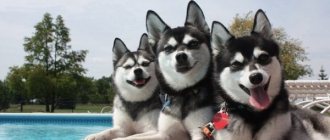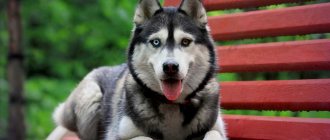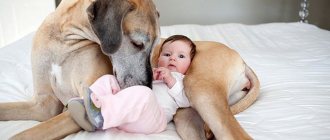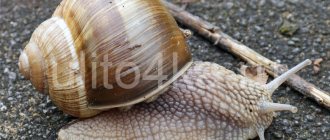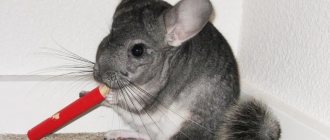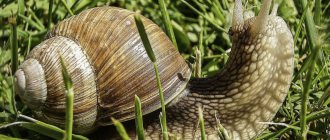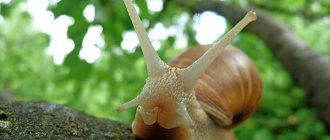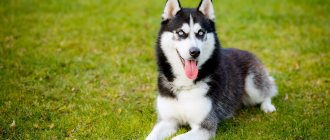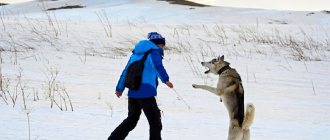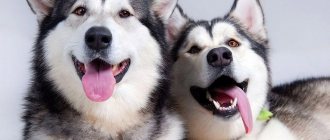Husky is an amazing dog. Many, having seen the expressive look of blue eyes in the photo and read about their good-natured character, dream of having such a pet. But representatives of this breed are not suitable for everyone. They require special conditions of detention, good upbringing and serious physical activity. After all, this is a working, sled dog, whose homeland is Siberia and the Far North. But despite this, huskies are a popular breed. People like not only her unusual appearance. Dog lovers are attracted by their unpretentiousness, friendliness, devotion and intelligence.
- pros
- Head
- Feeding rules
- What is the price
Breed traits
Breed traits (on a 5-point scale)
| Siberian Husky | |||
| Activity | in the house | 3.9 | |
| on the street | 4.6 | ||
| Obedience | training | 2.6 | |
| strangers | 3.5 | ||
| Domination | in family | 2.7 | |
| over dogs | 3.5 | ||
| Defending your territory | from people | 2 | |
| from dogs | 3.2 | ||
| Sociability | in family | 4.2 | |
| with strangers | 3.6 | ||
| with dogs | 3.4 | ||
| Concentration | in family | 1.8 | |
| in front of strangers | 1.9 | ||
| with dogs | 2 | ||
| Aggressiveness | in family | 1.6 | |
| to strangers | 1.9 | ||
| to the dogs | 2.9 | ||
| to cats | 3.5 | ||
| Family behavior | calmness | 3 | |
| demand for affection | 3.6 | ||
| excitability | 3.5 | ||
| playfulness | 4.2 | ||
| excessive barking | 2.3 | ||
| behavioral breakdowns | 3.1 | ||
| Tolerance for children | up to 4 years | 3.4 | |
| over 4 years old | 3.8 | ||
| Institutional use | watchman | 2.1 | |
| bodyguard | 2 | ||
This breed is often compared to the following dog breeds: Doberman Pinscher, Samoyed, Labrador Retriever, German Shepherd, Beagle.
Siberian Husky
Saluki
The second place is occupied by the Persian greyhound, or as it is also called - Saluki. She is not much inferior to the leader. The running speed is 67 km/h. At the same time, the animal is famous for its endurance and is able to run for 3-5 hours.
Saluki
The breed has existed for 5 thousand years. Salukis were kept in ancient Egypt. Archaeological artifacts bear an image of this four-legged pet. At home they get along with other pets. They love children and are friendly. In addition, she is clean and not whimsical.
History of the Husky breed
For many centuries, hardy, unpretentious dogs have lived alongside the indigenous inhabitants of the North of Siberia. Scientists believe that they were tamed 3 thousand years ago. Their ancestors were wolves, which was reflected in their appearance. These animals were used to transport goods over long distances, were protectors and full-fledged family members. They are ideally adapted to harsh climatic conditions.
This ancient breed has survived unchanged due to the long isolation of the northern peoples. Only at the end of the 19th century did they learn about unusual dogs outside their habitat. During the development of the North and Siberia, only they helped transport goods and people over long distances. But at the beginning of the 20th century, the new Russian government considered the breed unpromising and banned its breeding.
It was preserved thanks to the Americans. Back at the end of the 19th century, they imported these unusual dogs from Chukotka to Alaska. In America, they appreciated their endurance, speed, unpretentiousness and ability to work in a harness. The dogs were named “Husky,” which is the English word for “Eskimo.”
Their breeding began here. In the 1930s, the American Kennel Club recognized the Siberian Husky dog breed, and in 1934 it adopted the first standard. Until now, the country of origin is called the USA. In Russia, the revival of the breed began only in the 90s. By the beginning of the 21st century, the number of Siberian Husky puppies registered in Moscow reached one and a half hundred. Now many nurseries are open and exhibitions are held. But of all the varieties, the Siberian Husky breed is the most common.
History of Togo and Balto
These dogs became especially popular after the famous story of the delivery of anti-diphtheria serum to the city of Nome. This happened in 1925. During a severe snowstorm, a diphtheria epidemic broke out in the town. The medicine could only be delivered to the nearest railway station, which was located 1000 km from Nome. There were no roads further, and due to a snow storm and temperatures of minus 300, no planes could fly. Therefore, they equipped an expedition of 150 dogs.
The longest and most difficult part of the journey was done by Leonard Seppala's team. Its leader, Togo, chose the direction in the dark and helped to avoid holes and cracks in the ice. He was already an old dog, after such a race his legs gave out. The last part of the journey, 125 km, was done by the team of Gunnar Kaasen and the leader Balto. He was still young, but was able to find his way through a strong snowstorm. The medicine was delivered on time.
This path was called the “great race of mercy,” and it became known throughout the country. A documentary was made, the feat of these dogs is studied in schools. And in the town of Wasilla there is a small museum dedicated to this event. Balto is most glorified; he is known from a cartoon popular in recent years, and a monument was erected to him in a park in New York. Embossed on it are the words: “Endurance. Devotion. Intelligence". This is the best characteristic for these animals.
Interesting Facts
Now the Siberian Husky is popular all over the world. But not everyone knows that there are many interesting things associated with these dogs.
- There is another version of the origin of the name. The English word husky is translated as “husky.” These dogs began to be called that because they do not bark, but make hoarse sounds.
- Heterochromia is common in Husky dogs. They are born with different eyes: one is blue, the other is yellow.
- The sled can reach speeds of up to 35 km/h. Without a break, they can run more than 200 km.
- The Siberian Husky never gets cold. Thick fur allows it to sleep in the snow and withstand frosts of up to 600.
- This is one of the oldest breeds that has retained the features of wolves.
- Officially, the country of origin is called the USA, although they were originally bred in Siberia. This is reflected in the popular name - Siberian Husky.
- Although the first standard was adopted back in the 30s, the birth of the breed is considered to be 1966.
- Huskies often appear in films as wolves.
Deerhound - Scottish deer hound
A rare breed of deer hounds, they are valued for their speed, courage and intelligence. She was bred for only one purpose - to track the tracks of artiodactyls and bait victims during unarmed hunting.
The speed of a running, accelerated deerhound can reach 55 km/h. When hunting, deerhounds are energetic and tireless. They are willing to chase their prey for hours, making marching dashes in search of prey.
General characteristics of the breed
Husky head
The unusual appearance of these animals, which is emphasized in many photographs, has become the reason for their popularity. Many people buy a puppy, believing that they will grow up to be a good-natured, obedient pet. These are really smart, calm and not at all aggressive dogs. But anyone who intends to have a Husky at home needs to know about its characteristics.
They are related to the origin of the breed. She was not bred for the home, she is a working dog. The pack instinct is genetically embedded in her. In harsh conditions, these animals often had to make their own decisions; their owners relied on their instincts. Therefore, a pet can become too independent and freedom-loving, and will not obey if it does not recognize the owner as the leader of the pack. These dogs have a strong character and strive for leadership.
This is one of the smartest breeds. The pet understands all commands, although it does not always follow them. He will respond with love to everyone who is friendly and affectionate with him, but does not tolerate rudeness. Although huskies are not aggressive, this behavior can become a problem.
The following characteristics of Husky dogs can be noted:
| Parameter | Characteristic | Rating using a five-point system |
| aggressiveness | not aggressive at all | 1 |
| activity | very active | 5 |
| training | difficult to give in | 2 |
| friendliness | friendly with everyone | 4 |
| intelligence | smart | 4 |
| attitude towards loneliness | does not last long | 2 |
| security qualities | low | 1 |
| care | simple | 4 |
| molting | sheds a lot | 5 |
| health | strong | 4 |
| noise made | barks little, but howls | 2 |
pros
Husky puppy
It is not for nothing that the Siberian Husky is becoming increasingly popular in the world. It has many advantages:
- not aggressive, calm and friendly even with strangers, will never bite;
- gets along easily with other pets;
- active, loves sports, games, takes children on sleds, runs after a ball, can perform complex tricks;
- strong, resilient;
- sociable, curious, loyal;
- loves children and always treats them with care;
- not intrusive, understands when the owner has no time for him;
- barks a little;
- trainable;
- wool does not smell at all and does not cause allergies;
- it is easy to care for;
- unpretentious, adapts to any conditions;
- is in good health;
- eats little.
Minuses
In the snow
But before you decide to purchase a husky puppy, you need to know about the disadvantages of these animals:
- they shed twice a year and lose a lot of fur;
- if left alone they can howl like a wolf for a long time;
- often run away, make digs in the enclosure or under the fence, easily open the latches on the door;
- they like to dig, because of this the plants in the yard, carpets and linoleum in the apartment suffer;
- if they are bored, they may destroy the apartment, chew wallpaper, furniture, things;
- on the street they like to pick up and eat various waste and inedible things;
- cannot tolerate heat;
- you need to walk with them a lot - at least 4 hours a day;
- stubborn, self-willed and independent;
- They do not become guards or defenders, as they are friendly to everyone.
And the main drawback is that this pet can only be owned by active, active people who have a lot of time to raise and train the animal, to walk and communicate with it. The owner must be strong-willed, with leadership qualities, capable of gaining authority.
Varieties
Huskies are very similar to wolves
Popular message topics
There are about a dozen different natural zones on our planet. Dry and hot deserts, humid and favorable tropics, lifeless steppes - all this fills our home called Earth.
Owls have long been considered unusual birds. These are predatory animals that are found throughout almost the entire territory of our planet. You won't find them only in Antarctica and Australia. Owls never live in flocks. They have very good hearing,
One of the popular inhabitants of forests on earth, less often of open areas, is the owl. Among several species of this bird of prey, the polar owl has its own characteristics. She lives in the tundra of North America, Europe, and Asia.
Source
Description of the Husky breed
Now there are three varieties of Husky dogs. Breeders try to improve their characteristics by crossing them with other breeds. The names of the varieties are associated with the place of origin. The Siberian Husky breed is the basis from which all the others came.
- Alaskan came first. This is a driving option. It was bred in Alaska for racing and cargo transportation. Siberian huskies were crossed with malamutes, German shepherds, and border collies. The coat is shorter, distinguished by tenderness and devotion.
- Sakhalin is not very common and is found only on Sakhalin. This is a calm, strong, fearless animal. Often used as a service.
- In the 70s, the miniature husky or Klee Kai appeared. His height is only 33-39 cm, weight up to 7 kg. This small dog was bred specifically to be kept in a city apartment.
Sometimes huskies include dogs similar to them: Akita Inu, Malamute, Samoyed. But these are separate breeds.
The Siberian Husky belongs to the group of primitive type breeds, as it looks like a wolf. It differs from him only in his friendly, flexible character, but his appearance has remained virtually unchanged. This is clearly visible in any photograph.
Do I look like a wolf?
This is a medium sized breed. The height of female huskies at the withers is 50-56 cm, males are slightly taller - 55-60 cm. Despite this, they are hardy, the photo shows that the body is harmoniously built. When running, dogs move easily and freely, almost flying above the ground. Husky weight corresponds to size. Females weigh from 15 to 23 kg, males - 20-28 kg. The fact that females are smaller in stature does not affect their strength and driving performance.
When describing the appearance, people usually pay attention to the following features that are characteristic only of huskies:
- thick coat;
- "Fox's tail;
- face mask with two vertical stripes;
- ears stand upright.
Husky puppy
All Siberian Husky dogs are northern sled dogs. Despite this, they are now divided into three varieties, the descriptions of which are not much different.
- The workers are the ones from whom the breed actually originated. They are hardy, smart, unpretentious. When breeding, no attention is paid to external qualities. Previously, they were used to transport goods, now they are used for riding tourists.
- Racing dogs are specially bred dogs capable of developing great speed. Their distinctive feature is short hair and longer legs.
- Show animals are used for exhibitions. Representatives of the breed from America are strong-built, while European ones are more graceful. But their characteristic feature is that the muzzle is shorter. This reduces their adaptability to frost.
All varieties are popular, they are not very different from each other. All dogs are active and are often used in racing. Such sports as pulka, skijoring, bikejoring, and agility are common. They love to run, you can ride a bike with them, play Frisbee.
The lifespan of a husky is 12-15 years. But with good care and compliance with maintenance rules, they can live up to 17 and even 20 years.
Health
Of course, like all breeds, huskies are also prone to certain diseases. They tend to develop hip dysplasia, ectopia (urethral abnormalities), eye diseases (cataracts, corneal dystrophy, progressive retinal atrophy), and they may also develop a skin condition known as zinc reaction dermatosis. The average life expectancy of a husky is from 12 to 15 years.
Breed standard
The standard was created in the 30s, it was supplemented several times, but the basis for describing the appearance still remained the characteristics of a sled dog. From the photo of the husky you can see how muscular, strong and harmoniously built she is. Walks easily and gracefully.
Head
The head is proportionally folded, medium in size, triangular in shape. It is rounded at the top and tapers towards the eyes. The stop or transition from the forehead to the nose is well defined. The bridge of the nose is straight, the same length as the distance from the stop to the back of the head.
Muzzle
The muzzle is medium, cone-shaped, the cheekbones are well defined. The expression is good-natured, mischievous. From the photo you can see that the husky’s eyes are smart, interested, and beautiful.
Husky
They are almond-shaped, slightly slanting, and not widely spaced. The color is brown or light blue. Eyes may be different. The ears are medium, triangular, erect, directed upward. They are closely spaced, with rounded tips.
The jaw is strong, with black lips and a scissor bite. The teeth are sharp and strong. The nose is of the correct shape, its color can be any. It depends on the coat color. The standard allows brown, black with light veins, even flesh-colored.
Body type
The photo shows that the length of the body is greater than the height. The physique is harmonious, the gait is light and confident. The chest is wide and deep. These dogs have large hearts. The neck is muscular, of medium length; when moving, the head tilts forward. The back is flat, tapering towards the lower back.
Hunting
The tail is long, very fluffy, like a fox's, set below the level of the back. When the dog is calm, he hangs. When excited, it rises up. But it does not curl into a ring, but takes the shape of a sickle.
Limbs
The limbs are straight, set parallel. The elbows are pressed to the body, the thighs are muscular. The knees are mobile, located low, the joints are well defined. When moving, the forelimbs step easily, the hind limbs push off powerfully. The paws are more oval, heavily pubescent. The pads have thick skin, adapted for movement on hard crust.
Wool
Huskies have medium length fur. It is thick, with a fluffy undercoat, and not very hard. The warm coat allows the animal to sleep in the snow at temperatures down to 250.
Husky blue eyes
Color
The standard allows for different husky colors and patterns. All of them are common, but some are especially popular.
- The rarest and most beautiful is the white husky. This is not an albino, the eyes and nose are dark. The coat is snow-white, stains are not allowed.
- Gray-white and black-and-white colors are more common. The fur is darker on the back and upper part of the tail, and there is a mask on the muzzle. The undercoat may be silver.
- Red or chocolate is often combined with white.
- The fawn color looks beautiful. White belly, paws, beige top.
- The traditional color is wolf. Gray goes with dark gray and even black. There is a dark mask on the muzzle, lighter cheeks.
- The classic color is also black. White or gray spots and red tan are allowed, but not more than 25%.
There are individuals with silver, merle, tricolor, and piebald colors.
Failure to meet the breed standard
Each breed standard has clear characteristics. Dogs with defects are rejected and not allowed for breeding.
- very light refined head or rough;
- wide-set or close-set eyes;
- very wide or pointed muzzle;
- the tips of the ears are directed to the sides;
- short neck;
- a tightly curled or low-set tail;
- long or too coarse coat;
- mincing gait.
Hungarian Vizsla – 60 km/h (record – 64 km/h)
The Hungarian Cops are very different in appearance from the other finalists. Vizslas are very muscular, strongly built dogs with a wide, proportional skull. Unpretentious to care for, but very sociable animals are loved by many people. Vizslas are one of the 10 fastest dogs: their speed can exceed 60 km/h!
Husky character
Husky photo
Each breed has its own personality traits. They are determined by the purpose for which it was bred and used. For huskies, this means transporting goods in harsh weather conditions. Thanks to this, the following character traits have developed:
- complete absence of aggression towards the owner and other dogs;
- high mobility and performance, the desire to constantly move;
- devotion and affection to one owner;
- intolerance of loneliness, they need communication;
- unpretentiousness and good adaptability.
One of the advantages of this pet is its love for children. He treats them with care, even if they inadvertently caused them pain. Never bites or growls. Northern peoples used to use these animals to warm babies. Now this dog will become a devoted and caring friend for a child. The pet accompanies him everywhere, plays, and does not let anyone offend him.
This is a companion dog, more suitable for the role of a friend. Not suitable as a security guard or watchman. She has no aggression, and has not developed the instinct to protect the territory. It will only protect its owner from those who behave aggressively. And a calm thief can be greeted kindly.
Husky muzzle
These animals are not used as hunting animals, although they have long been able to obtain their own food. They have a hunting instinct, but they do not bring prey to the owner. They also cannot become a service dog, since they are very independent and will not immediately follow all orders.
These animals really need long-term physical activity. You need to walk them a lot, preferably running and playing. If the pet is not tired, it will misbehave at home. The main reason for things to get damaged is boredom.
The character flaws of these dogs include willfulness, stubbornness, and independence. They are used to making decisions on their own and being on an equal footing with a person. Males are very freedom-loving and strive for dominance, while females are cunning and resourceful. Because of these character traits, running away is a common problem. Huskies do not like to stay at home for a long time; they can break glass and quickly figure out how to open the latch. But they often run away from the yard - they can jump over a high fence or dig under a hole.
Purpose
Despite the fact that Huskies are considered a sled dog breed, they are increasingly being adopted as companion dogs. One way or another, this is a dog for people leading an active lifestyle. Due to their good-natured disposition, huskies are not used as guard or guard dogs. Using them as a hunting dog is also quite difficult. And if the dog takes the game without asking questions, then it won’t be easy to give it back to the person. Attempts to develop aggression for security purposes can result in mental disorders. It is believed that a husky will never, under any circumstances, bite a person, but it is worth considering that the characteristics of a particular dog, the conditions of its raising and maintenance may be important.
Raising and training a husky
Huskies are very smart, but headstrong animals. Inexperienced dog breeders who have no experience in training should not get such a pet. The breed is also not suitable for weak-willed people who will not be able to show persistence and firmness. These dogs can be taught a lot, as they are intelligent. But in order for a husky to begin to obey, you need to become an authority for him.
Husky
The most important thing is that these dogs should not be raised roughly, using violence. They can become embittered and completely uncontrollable. They will try to avoid punishment, but will not begin to behave better. They begin training when the puppy arrives at home - no later than 2-3 months. At this age, it is easy to teach your pet basic commands.
When raising a Husky, you need to follow several rules.
- All family members should treat the pet equally and have the same requirements. The dog will not understand what they want from it if one scolds and the other praises for the same thing.
- Physical punishment must not be used. You need to praise for all good deeds and following commands. You need to react strictly to unwanted behavior, but it is better to distract your pet rather than hit it. As a punishment, you need to demonstrate your dominance - grab the dog by the withers, press it to the floor and hold it until it calms down.
- Aggression towards the owner, the desire to fight with other dogs and actions that cause harm to the animal should be strictly prohibited.
- Fairness is very important, Huskies feel this keenly. They also recognize falsehood and pretense. You need to respect and love your pet.
- They also react to voice intonation. It is best to give the command calmly and firmly. But many owners notice that these dogs comply with requests faster.
- When training, it is important to repeat one command many times, not immediately, but several times during the day. You need to be persistent in getting things done. But the monotonous repetition of the same commands will quickly bore your pet.
- In order for a Husky to be trained, it needs to be interested. Then he won't be distracted. It is best to conduct training in the form of a game.
It is important to teach your puppy basic commands. He must respond to his nickname, know the place. Important commands are “Come to me”, “Fu”, “Nearby”. Dogs of this breed have a genetically inherent habit of dragging something. Therefore, you need to teach them the commands “Stop”, “Forward”, “Left”, “Right”. This will help avoid problems while walking.
Raising an adult dog is more difficult than raising a puppy, but it is possible. You need to act patiently and consistently.
Dalmatian
Dalmatian It would seem that Dalmatians were bred solely for beauty; their spotted coloring is visible from afar and immediately lifts the mood. However, the speed qualities of the motley black and white dogs are impressive - Dalmatians easily reach 60 km per hour , ahead of greyhounds. The breed has ancient historical roots, with the first paintings of Dalmatians dating back to the 1600s. They were bred for protection and simply as companions, and they needed speed to keep up with the carriage in which the owner was riding.
Dalmatians and horses
After all, on the way he can be attacked, and dog protection has always been highly valued! Today, Dalmatians remain devoted guards and friends of humans; the breed is assessed as human-oriented, however, such a dog should be trained from puppyhood, because they are sometimes prone to amateur activities and are overly independent. But if they treat themselves properly, these dogs get along with children and other pets and communicate a lot with their owners. They are short-haired, born pure white, and grow up to 60 cm as adults.
Conditions of detention
A private house with a large yard is more suitable for keeping these dogs. They can be left outside even in winter. It is necessary to properly equip the closed enclosure. To prevent your pet from digging or jumping over the net, you need to provide for all this.
Siberian Husky
Beginning dog breeders often have a question: is it possible to keep a husky in the city? They feel best in the wild, but if several conditions are met, they adapt to life in an apartment.
- There must be one family member at home so that the pet does not feel lonely. If possible, you need to get a second dog.
- It is necessary to walk the dog for a long time. She must be tired so that there is no desire to be naughty at home. Some people who are thinking about getting a husky give up the idea when they find out how much walking they need to do. Not everyone has 4-5 hours of free time.
- You need to leave your pet toys and chewing bones. It is just not recommended to give soft toys.
Notable fugitives
Huskies have a well-earned reputation as runaways who will wander off into parts unknown if given the chance, and many of these beautiful dogs have been injured or lost as a result of such runaways. Huskies can jump over fences, crawl under fences, break chains, slip out of collars, and perform other tricks that would make Houdini proud to escape their captivity.
An attractive image is easy to maintain even after 50 years: 10 fashionable men's haircuts
Choosing a haircut by age: how to get a haircut at 30, 40, 50, 60 years old
Aquarius - listen to intuition: forecast for all signs for the spring equinox
Features of caring for a husky
Although this dog is unpretentious, it needs care. It is simple, but without it the pet will be uncomfortable and may get sick. Routine animal care activities will be required.
- Comb 1-2 times a week with a long-toothed comb and brush the coat. During shedding, brush the undercoat daily with a slicker brush.
- You need to brush your teeth regularly. In modern dogs, tartar builds up quickly. Therefore, it is recommended to buy paste and a brush at the pet store. To clean the teeth, you also need to give your pet special treats and bones.
- Check your ears and remove dirt and excess wax if necessary.
- If discharge accumulates in the corners of the eyes, wipe them with a cotton pad moistened with boiled water.
- Usually in the city, your pet's claws get worn down on the asphalt. But it is recommended to check them regularly and trim them if necessary.
- Huskies don't need to be bathed often. They are clean, lick themselves like cats. If necessary, they wash their paws. Bath when heavily soiled, but not more than 2-3 times a year. You can simply wipe the wool with a damp cloth.
- Carry out helminthiasis prevention 2-3 times a year. Wear a flea and tick collar.
Feeding rules
A husky's diet should be complete; the animal's health and appearance depend on it. It is best to feed him high-quality dry food. It must be super premium. When choosing food for your husky, it is recommended to consult a veterinarian. Acana Advance, Arden Grange, Brit Care, Eukanuba and other varieties designed for active dogs are suitable. They contain all the necessary vitamins and minerals. If the chosen food is not suitable, the food needs to be changed.
Husky appearance
It is more difficult to create a natural diet. It must include at least 70% meat. It is given boiled or scalded with boiling water. Low-fat varieties without bones and skin are suitable. It is acceptable to give fish occasionally, just be sure to remove the bones. When feeding natural food, they give porridge; about 10% of the diet should be vegetables. You need to add vegetable oil to food, give yolk, fruit, and fermented milk products. Instead of bones they give cartilage.
You should not feed your dog the following food:
- pork, lamb;
- pasta, bread;
- sweets, chocolate;
- smoked meats, sausages;
- potatoes;
- milk.
It is necessary to give your dog treats. With natural feeding, these are dried offal, dried meat, ears, cartilage. If your pet eats dry food, these are industrially produced dog biscuits and bones.
You cannot mix two types of food, so it is advisable to decide on it before purchasing an animal. You need to know how many times to feed your pet. Puppy 5-6 times, adult dog twice a day. The amount of food depends on age, weight and physical activity. Animals kept outside need more food in winter. For any feeding method, it is recommended to give the animal vitamin and mineral supplements.
Possible diseases
Huskies rarely get sick. This is due to their genetic characteristics. Sometimes the following diseases may occur:
- diabetes;
- neurological diseases;
- eye diseases;
- dermatitis;
- allergy;
- joint dysplasia;
- epilepsy.
Afghan Hound – 50-60 km/h
Afghan hounds are one of the most beautiful hounds. Their long silky coat, intelligent, expressive eyes and wonderful character make many people fall in love with them. Afghan hounds are very playful and social pets, but they will not be able to take a dominant position among other animals. Beautiful dogs are agile and dexterous hunters, excellent jumpers and runners (their average speed is not less than 50 km/h, but sometimes exceeds 60 km/h).
How to choose a puppy
If you decide to get such a dog, you need to carefully choose it. A husky puppy must be purebred, with a pedigree. Only this can guarantee the presence of characteristic behavioral features. They buy a baby at 2-3 months of age.
Husky puppy
It is advisable to immediately determine the gender of the pet. Males are calmer, but willful and less amenable to training. Bitches are obedient, but cunning and go into heat twice a year. The puppy must be examined before purchase. He must be cheerful and active. The absence of dandruff, nasal or eye discharge is important.
What is the price
The price of a good puppy cannot be low. A dog without a pedigree can be purchased for 6-10 thousand rubles. But she may turn out to be not purebred, with defects or genetic pathologies. Therefore, it is better to buy a puppy from a kennel. Its cost will be higher, but there is a guarantee that the pet will delight its owners with its cheerful, mischievous disposition and unusual appearance. The price of puppies with a pedigree starts from 20 thousand rubles. Premium class show dogs cost at least 50 thousand.
Huskies are popular dogs, beautiful and smart. Even their high price does not stop many. But not everyone can have such a pet. You should not give a husky to a child, or bring it into a small apartment, an elderly person or a homebody. It requires great physical activity, proper upbringing and respectful attitude. Only then will this dog become a beautiful companion, obedient and loyal.
Border Collie
Initially, the breed is considered a herding breed, so at the genetic level the ability to move quickly and control everything is inherent. Running speed varies within 48 km/h.
Border Collie
Due to its good-natured nature, the border collie has gained popularity. The animal is easy to train. In one day, a dog can learn up to three commands.
Peculiarities:
- unpretentiousness;
- friendly attitude towards children;
- devotion;
- learning ability
What does a dog need?
Before you bring your puppy home, you need to prepare:
- a house or bed where the pet will sleep and rest;
- toys;
- collar and leash - to ensure the safety of the dog, it should only be walked on a leash;
- bowls for food and water;
- care products - shampoo, conditioner, brushes, combs, slickers, nail clippers, toothbrush and paste.
In the case of outdoor keeping, it is also necessary to equip a sufficient area, a well-fortified enclosure around the perimeter, a comfortable kennel with a roof and a canopy that protects from the sun and precipitation.
Whippet
From its appearance it is immediately clear that the Whippet is a born runner. Long hind limbs and a muscular body help develop dynamics of up to 60 km/h.
Whippet
The Whippet is extremely sensitive. They subtly sense the emotional situation. Due to rough treatment, he can become very upset and even get sick. Therefore, when training, you cannot use physical methods of influence.
The Whippet is a loyal creature that gets along well with all family members. Loves affection and attention from the owner. In addition, he has high intelligence and rarely shows aggression.
No. 8. German Shepherd – 48 km per hour
The German Shepherd is the second most popular breed in the world. Originally used for herding sheep. Today, the shepherd dog is used in police and military work, as a guide for the disabled, for detecting drugs and explosives, and in search and rescue work. Loyal, caring, friendly dog is ideal for a family, easy to train and very intelligent.
Greyhound
The champion dog runner is the Greyhound. They are capable of accelerating up to 70 km/h. The athletic build and muscular limbs allow you to quickly cover short distances.
Greyhound
He is not capable of running marathons. The Greyhound quickly gets tired and loses momentum. The history of the species goes back to 3,000 BC. At home, the animal behaves calmly. They can even be kept in an apartment.
Italian Greyhound
The Italian greyhound with a running speed of 40 km/h took fourteenth place. It appeared 2,000 years ago in Greece, after which it came to Italy. They treated the dog with attention, gave him his own place and worried about his comfort. Only wealthy people could own an Italian greyhound.
Italian Greyhound
Italian Greyhound is miniature. The height of an adult male does not exceed 35 cm, and the maximum weight is 5 kg.
Irish Wolfhound
Representatives of the breed accelerate to 45 km/h and rightfully occupy twelfth place on the list. 500 years ago, this representative of the canids was used to bait wolves. Now the main calling is considered to be hunting game. At home they are proud of the breed. For the Irish it is of great importance and even takes part in royal ceremonies.
Irish Wolfhound
Among the greyhound family, the Irish Wolfhound is the largest representative. Body height is 86 cm, and weight reaches 55 kg.
